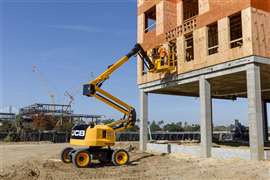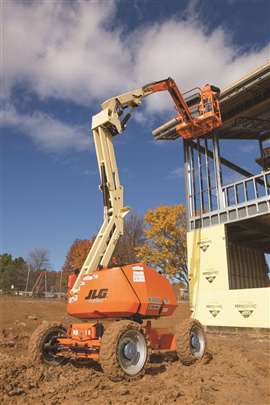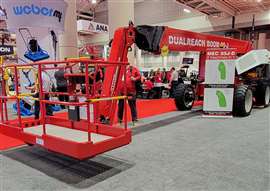Top tips for purchasing articulated boom lifts for your fleet
04 September 2024
Articulated boom lifts are continuing to grow in popularity on jobsites due to their up-and-over efficiency, coupled with low noise and the ability to use accessories for niche applications. But these machines are evolving quickly, so we spoke with industry experts to find out what you should consider when choosing one for your fleet. Lindsey Anderson reports.
A natural rental item, today’s articulated boom lifts offer fleet owners a versatile machine that can fit into almost any situation. More and more electric and hybrid models are making these machines ideal for use indoors or in residential areas. Here’s what leading industry experts had to say.
Domink Damm, global product director, booms, Genie
The first step is to know your customer and understand their applications and jobsite needs. Beyond that, rental houses can make sure their employees know and understand the benefits of an articulating boom lift, so they can help recommend applications where an articulating boom lift might be able to increase productivity and efficiency.
The second is to consider the total cost of ownership, rather than just the initial purchase price. That includes how much it will cost to maintain the machine over its lifespan, as well as the cost of repairs and lost

rental revenue if the machine breaks down. TCO also includes residual value, and how much you can expect to get for the lift on the secondary market when you’re ready to replace it.
The third pertains to electrified machines in particular: Making sure that the battery solution is a well-tested, quality product, especially with lithium-ion.
Lithium-ion refers to battery chemistry, but the batteries themselves can be vastly different, and quality can vary dramatically. A high-quality lithium-ion solution should be designed specifically for the equipment it is being used in, so you can be sure it can withstand the conditions it will face on jobsites. Likewise, whether the equipment was purpose-built as an electric machine or a converted diesel model can also impact battery performance. Finally, it’s important to understand what testing occurred to ensure longevity and reliability, and what certifications, if any, the battery has received.
Sinoboom North America
Take into account the total cost of ownership over the equipment’s lifespan, including maintenance, repair, and operating costs. Opting for a higher-quality, more reliable model might entail a higher upfront investment but could save you money in the long-term by reducing downtime and repair expenses.
Understand your applications; evaluate the specific requirements of projects and understand the needs of different products which will increase the working efficiency.
Consider future scalability; anticipate potential growth or changes in your operations and choose a boom lift model that offers scalability.
Connor Stanmore, product manager, JCB
Invest in telematics and connectivity. Select lifts with integrated telematics for real-time monitoring and data analysis. This technology helps you track equipment usage, schedule maintenance proactively and optimize fleet management, ultimately reducing downtime and operational costs.
Second, prioritize advanced safety features. Look for machines equipped with enhanced safety features such as immobilizers, load-sensing technologies and live load management information. This technology reduces accident risks and ensures maximum protection for operators and nearby workers.
Nate Hoover, director of product management, JLG

When equipment owners are looking to purchase new articulating boom lifts, we suggest following these three tips before making their decision:
1) Look at more than just the purchase price of the machine. Fleet managers should consider everything from their budget to the specific tasks that must be completed with the machine. For example, having too much — or too little machine — can present challenges. It’s important to evaluate the available options based on machine specifications like stability and capacity, as well as the brand’s reputation for reliability and safety.
2) Calculate the machine’s total cost of ownership over its lifetime. Fleet managers should account for factors like financing the purchase, parts availability, maintenance intervals, service and warranty work, telematics and digital tools to manage the equipment, operator and technician training, and the brand’s resale value.
3) Ask what else the brand provides to support its products. Fleet managers should understand what accessories, options, tools, and technologies the manufacturer offers to enhance the users’ experience with its equipment. They should also be able to access the information they need to know to successfully own and operate an OEM’s articulated boom lift.
Gary Crook, VP of engineering, MEC Aerial Work Platforms
Consider when the machine will be used on improved or rough-terrain surface applications. Is up-and-over clearance height more or less important than outreach? Would the premium for an electric/hybrid machine in application flexibility be the wiser choice over traditional diesel engine power?
Advancements in electrification of articulated boomsA key factor to consider when purchasing an articulated boom lift is its power source. Electric and hybrid models are becoming increasingly common choices due to the benefits they can offer in reducing carbon emissions as well a noise on jobsites. “The shift towards electric and hybrid boom lifts has been largely driven by the need for lower emissions, quieter operation, and compliance with environmental regulations,” says Connor Stanmore, product manager, JCB. “As battery technologies develop, it makes it a much more viable solution on all sites because of the extended use time, which therefore reduces downtime and increases productivity. While there may be a higher initial investment into electric/hybrid articulated boom lifts, more customers are starting to recognize the long-term fuel cost savings, maintenance and operation efficiency that often result in a lower total cost of ownership.” Nate Hooever, director of product management at JLG, notes that JLG currently offers several boom lift models with electric or optional electric power. “Specific articulating boom lift models include the H340AJ, E300AJP, E400AJPN and E450AJ models. These machines are proven to produce reduced emissions and offer a quieter work area, providing our customers and users with environmentally friendly, energy-efficient products that reduce carbon footprints and noise pollution while keeping productivity on job sites high. JLG electric articulating boom lifts also require less scheduled service because they depend less on hydraulic oils.” 
Electrified models are ideal for indoor environments and residential areas, notes Sinoboom North America, whose models feature fast charging capabilities, “reaching 100% in just 4-7 hours, minimizing downtime, while regular charging takes about 6-13 hours.” MEC’s recently introduced DualReach 85-J Boom is available in a Hybrid power source. “A single AC motor driving into a 4WD axle-based drive system produces the highest energy efficiency and the simplest motor control parts,” explains Gary Crook, VP of engineering, MEC Aerial Work Platforms. “A small and fuel-efficient generator extends the duty cycle range, allowing up to one month of electric machine operation from one tank.” Genie has been at the forefront of electrification for some time now, says Dominik Damm, global product director, booms, Genie, noting the company’s FE hybrid lifts and its DC electric articulating boom lifts models. “Genie’s investment in Acculon Energy will help us continue to be a leader as we move into the next generation of battery technology,” says Damm. “While we aren’t ready to talk about what’s coming next, I can tell you I’m excited about the projects in our development pipeline. The solutions will be purposefully developed and rigorously tested for reliability, durability, and will add value in terms of the total cost of ownership.” |
MAGAZINE
NEWSLETTER
CONNECT WITH THE TEAM






